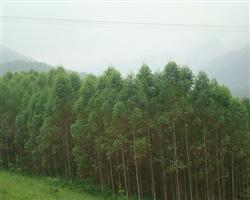Fertilization technology of eucalyptus

Eucalyptus is one of the three fast-growing tree species with developed root system, strong absorption and large growth. There is an adequate supply of water and fertilizer, with a height of 1.5m per year and 5.5 meters high, and it can be cut and used in 4-5 years. The main nutrient elements absorbed by eucalyptus are nitrogen, phosphorus, potassium, calcium, magnesium, zinc, boron and so on. According to the study, each eucalyptus tree absorbs 36 grams of nitrogen, 2.8 grams of phosphorus, 20 grams of potassium, 31 grams of calcium and 8.5 grams of magnesium per year, and the order of absorption is nitrogen > calcium > potassium > magnesium > phosphorus. The absorption ratio of nitrogen, phosphorus and potassium is 13:1:8. Nitrogen-deficient plants lose green or become purplish red, and their growth is hindered; potassium-deficient plants are weak, easy to lodge, and the leaves are dull and dull; calcium and magnesium can increase the resistance of eucalyptus, make the eucalyptus grow rapidly, the tree shape is straight and symmetrical, and the yield is high; zinc and boron promote the top growth of eucalyptus, if lack of these two elements, eucalyptus will appear terminal bud dry or tender bud swelling and brittleness, easy to wind break, form weak clumps and so on, which seriously affect the growth of eucalyptus. Second, fertilization technology eucalyptus fertilization should first meet the needs of eucalyptus for various nutrients; secondly, to achieve an appropriate amount, with the minimum fertilizer input to achieve the maximum economic benefits; thirdly, to master fertilization methods to improve fertilizer use efficiency. Eucalyptus fertilization is carried out according to the following methods: base fertilizer: seven days before planting, compound fertilizer or eucalyptus special fertilizer 0.25ml 0.5 kg is applied to each hole, and the fertilizer is applied into the hole and backfilled with a layer of topsoil 1m / 2cm thick. Topdressing: one month after planting or after the young tree grows 1 meter high, topdressing begins. 0.25 kg of compound fertilizer or special eucalyptus fertilizer is applied to each plant to promote the early growth and rapid development of eucalyptus. In the second year, topdressing once from March to April, 0.5 kg of compound fertilizer or eucalyptus fertilizer is applied to each plant. In the third and fourth years, each plant was topdressing once, and 0.8 kg of compound fertilizer or special fertilizer for eucalyptus was applied to promote the rapid growth of eucalyptus, which could be cut down in 4-5 years, and the wood yield per mu could reach 6 rain and 8 cubic meters. Main points of topdressing: 1. Before each topdressing, weeds must be removed to avoid weeds competing for fertilizer. 2. 30 cm away from the root, in the uphill direction of the root, open a crescent-shaped fertilizer ditch or open a fertilizer hole above the root, on the left and right sides, and cover the soil after application to prevent fertilizer loss. 3. It is best to apply fertilizer after rain, and the fertilizer is easy to be absorbed. 4, the slope ridge, the soil is thin and thin, should apply more fertilizer, the gully side valley, the soil is thick and fertile, should apply less fertilizer, adjust measures to local conditions, reasonable dosage, save cost and improve benefit. 5. Soil testing and fertilization should be carried out according to the suggestion card of soil testing and fertilization given by the technical department to save cost and increase efficiency.
- Prev

Morphological characteristics of eucalyptus
Evergreen plants have periodic shedding of old leaves within a year. Most species are tall trees, a few are small trees, and few are shrubby. The shape of the crown is steeple, multi-branch, weeping branch and so on. Leaves simple, entire, leathery, sometimes covered with a thin waxy layer. Leaves can be divided into young leaves, middle leaves and mature leaves.
- Next

Introduction to the skills of topdressing in the growth process of Eucalyptus
Eucalyptus red leaf blight is a physiological disease, which is mainly caused by the serious lack of B, one of the trace elements necessary for normal plant growth and seed setting. Etiology: B affects carbohydrate synthesis and transport, cell division, cell maturation, cell wall and pollen tube formation in the process of plant growth and flowering.
Related
- Fuxing push coffee new agricultural production and marketing class: lack of small-scale processing plants
- Jujube rice field leisure farm deep ploughing Yilan for five years to create a space for organic food and play
- Nongyu Farm-A trial of organic papaya for brave women with advanced technology
- Four points for attention in the prevention and control of diseases and insect pests of edible fungi
- How to add nutrient solution to Edible Fungi
- Is there any good way to control edible fungus mites?
- Open Inoculation Technology of Edible Fungi
- Is there any clever way to use fertilizer for edible fungus in winter?
- What agents are used to kill the pathogens of edible fungi in the mushroom shed?
- Rapid drying of Edible Fungi

